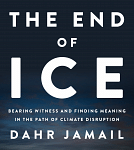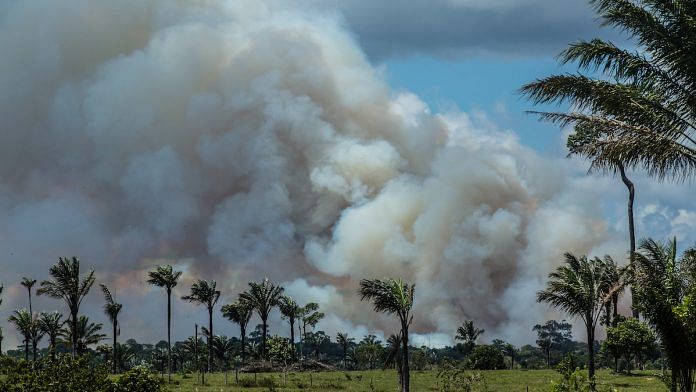The deliberate obfuscation of truth on global warming and sometimes outright omission of media coverage on climate disruption is similar to the media’s role in covering the US occupation and invasion of Iraq.
As a journalist, I was motivated to provide accurate coverage of the catastrophic consequences the Iraq invasion had on its people. I approached the issue of climate change with the same motivation to cut through the propaganda.
First, the bad news
Here’s why the media’s coverage needs to change.
The five hottest years ever recorded on planet Earth were the last five years. We are already in the Sixth Mass Extinction event, of which human-caused climate disruption is the driving force.
A study published in Nature magazine last October showed that over the last quarter-century, the oceans have absorbed 60 per cent more heat annually than estimated in a 2014 IPCC report. The study underscored the fact that the globe’s oceans have already absorbed 93 per cent of all the heat humans have added to the atmosphere; that the climate system’s sensitivity to greenhouse gases is far higher than previously thought; and that planetary warming is far more advanced than had previously been grasped.
To give you an idea of how much heat the oceans have absorbed, let’s think of it this way: if that heat had instead gone into the atmosphere, the global temperature would be a staggering 36℃ hotter than it is today.
Also read: SK Satheesh: India’s top climate scientist who’s demystifying greatest pollutants on earth
Two weeks after that Nature article came out, a study in Scientific Reports warned that the extinction of animal and plant species thanks to climate change could lead to a “domino effect” that might, in the end, annihilate the entirety of life on the planet. It suggested that organisms will die out at increasingly rapid rates because they depend on other species that are also on the way out. It’s a process the study calls “co-extinction”. According to its authors, a 5-6℃ rise in average global temperatures might be enough to annihilate most of Earth’s living creatures.
To put this is in perspective: just a 2℃ rise will leave dozens of the world’s coastal mega-cities flooded, primarily because of melting ice sheets in Greenland, Antarctica, and the thermal expansion of the oceans as they warm.
There will be 32 times as many heat waves in India and nearly half a billion more people will suffer water scarcity.
At 3℃, southern Europe will have permanent drought and the area burned annually by wildfires in the US will sextuple. These impacts, it’s worth noting, may already be baked into the system, even if every country that signed the Paris climate accord were to fully honour its commitments, which most of them are not currently doing.
At 4℃, global grain yields could drop by half, most likely resulting in annual worldwide food crises (along with far more war, general conflict, and migration than happening now).
The International Energy Agency has already shown that maintaining our current fossil-fueled economic system virtually guarantees a 6℃ rise in the Earth’s temperature before 2050. To add insult to injury, in 2017 analysis by oil giants BP and Shell indicated that they expected the planet to be 5℃ warmer by mid-century. The UN warned in November 2018 we are on track for at least 3℃ warming by 2100, and even the Trump administration believes we are heading for 4℃ by then.
Human-caused climate disruption is an existential crisis that is worsening by the day.
Also read: Climate change may have finished off Indus Valley Civilisation
No news
Most of the mainstream media consistently choose to ignore this either by complete omission or by downplaying the crisis.
In the United States, for example, the media watchdog group Fairness and Accuracy In Reporting (FAIR) revealed in June 2017 that in all of the first dozen major interviews with Donald Trump, not once was he asked about human-caused climate change.
And this wasn’t just mainstream television ignoring the issue. The outlets complicit in the omission include The New York Times, the Associated Press, and Reuters, among the usual suspects of the far-Right Fox News and Breitbart.
In another example, when Hurricane Florence struck the US in 2018 and brought record rainfall and widespread devastation, the media failed to connect the obvious dots again. Despite ample science showing that warming would cause Florence to bring twice as much rain compared to a storm occurring in normal temperatures, the New York Times, which had the most Florence-related stories mentioning climate change, still only did so a miserable 20 per cent of the time. In fact, 19 of the top 50 newspapers in the US with stories on the hurricane failed to ever mention climate change in their hurricane coverage.
Also read:The climate change battle will be won or lost in China
Distressingly, there are even more egregious examples of minimisation of the dire impacts of climate change in the mainstream media. USA Today, another national paper that is widely read across the country, described the forecasting of another El Niño as, “Forecasters Say El Niño Will Keep Cold Under Control” for its influence on winter across the US rather than citing the science that shows human-caused climate disruption as the key driver of temperatures escalating towards realms that could ultimately be the demise of our own species. Another of their headlines on the topic (“Winter Forecast: Warmer-Than-Average Temps Expected for Most of USA, Thanks to Developing El Niño.”) literally provided a “thanks” to the warmer temperatures.
With media “coverage” like this on the single most important story for planet Earth, it’s no wonder why more people are not nearly as alarmed as they should be about human-caused climate disruption.
The author is an award-winning journalist who reports on human-caused climate disruption and the environment. He was also one of the few unembedded journalists to report extensively from Iraq following the 2003 invasion.
 He recently published The End of Ice: Bearing Witness and Finding Meaning in the Path of Climate Disruption.
He recently published The End of Ice: Bearing Witness and Finding Meaning in the Path of Climate Disruption.




Assertions difficult to believe. A journalist should report facts and references to scientific theories.
That “a 5-6℃ rise in average global temperatures might be enough to annihilate most of Earth’s living creatures” is not consistent with what we know on past climate changes (e.g.: extinction rate during recent ice ages).
Why the warming should cause water scarcity? We know that past warm ages were wetter and cold ages dryier than present climate (logical: higher temperature = more evaporation = more rain). Why should this time happen the opposite?
Why grain yields should drop? when huge areas of land should become arable in Canada and Russia. Which regions will become too hot to become unsuitable for any food crop?
The worst hurricanes recorded in history occurred at the end of the 15th and beginning of 16th cnturies. A couple of strong hurricanes dont’t provide enough statistically valid data to show that they represent a variation of the average strenght.